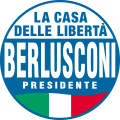House of Freedoms
House of Freedoms Casa delle Libertà | |
|---|---|
 | |
| Leader | Silvio Berlusconi |
| Other leaders | Gianfranco Fini Pier Ferdinando Casini Umberto Bossi |
| Founded | 2000 |
| Dissolved | 2008 |
| Preceded by | Pole for Freedoms |
| Succeeded by | The People of Freedom (merger: FI, AN, minor parties) Centre-right coalition |
| Political position | Centre-right[1][2] |
The House of Freedoms (
History
The CdL was the successor of the
In the run-up of the 2001 general election, after a six-year spell in opposition, which Berlusconi called "the crossing of the desert", he managed to re-unite the coalition under the "House of Freedoms" banner. According to its leader, the alliance was a "broad democratic arch, composed of the democratic right, namely AN, the great democratic centre, namely Forza Italia, CCD and CDU, and the democratic left represented by the League, the New PSI, the PRI and, at least I hope so, Cossiga".[4][5]
The CdL won the 2001 general election by a landslide and, consequently, the
In 2003 the CdL was routed in local elections by The Olive Tree and the LN threatened to pull out. Also the 2004 European Parliament election were disappointing for FI and the coalition as a whole, even though AN, the UDC and the LN did better than five years before. As a result, Berlusconi and FI were weaker within the CdL.
In 2005 the coalition lost heavily in
In the 2006 general election the CdL, which had opened its ranks to a number of minor parties, lost to The Union coalition, led by Romano Prodi.
In the run-up of the
The alliance has since been generically referred to as the centre-right coalition.
Composition
From 2000 to 2006
It was initially composed of the following political parties:
From 2006 to 2008
Composition during the 2006 general election:
Electoral results
Italian Parliament
| Chamber of Deputies | |||||
| Election year | Votes | % | Seats | +/− | Leader |
|---|---|---|---|---|---|
| 2001 | 16,915,513 (1st) | 45.4 | 368 / 630
|
–
|
|
| 2006 | 18,995,697 (2nd) | 49.7 | 281 / 630
|
||
| Senate of the Republic | |||||
| Election year | Votes | % | Seats | +/− | Leader |
|---|---|---|---|---|---|
| 2001 | 14,406,519 (1st) | 42.5 | 176 / 315
|
–
|
|
| 2006 | 17,359,754 (1st) | 49.8 | 156 / 315
|
||
Symbols
-
2001–2008
-
Electoral logo
References
- ISBN 978-1-317-96809-2.
- ISBN 978-0-7735-3896-2.
- ISBN 978-1-317-53502-7.
- ^ "Polo, lo sgarbo di Bossi - la Repubblica.it". 25 January 2001.
- ^ "Archivio Corriere della Sera".
- ^ "Archivio Corriere della Sera".
- ^ "Archivio Corriere della Sera".
- ^ "Archivio Corriere della Sera".
- ^ "Archivio Corriere della Sera".


